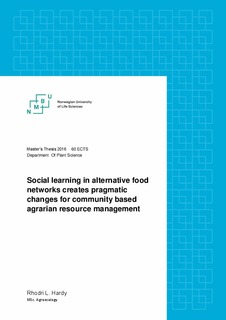Social learning in alternative food networks creates pragmatic changes for community based agrarian resource management
Master thesis
Permanent lenke
http://hdl.handle.net/11250/2434829Utgivelsesdato
2016Metadata
Vis full innførselSamlinger
- Master's theses (IPV) [240]
Sammendrag
The need for more sustainable management of natural resources is becoming increasingly important as the global population increases. The implementation of management strategies are showing signs of change as a response to the shortcomings and discontent that have accompanied different paradigms. Community based resource management (CBRM) is emerging as a response to this discontent, it is a strategy that promises to develop more inclusive and equitable management of resources. The objective of this research is to contribute to the understanding of how collaborative learning can aid the development of CBRM, whilst also identifying some challenges to the application of this management approach. As an action oriented case study, I will be investigating how this strategy can be applied to our agrarian resources. I follow the journey and progress of participants looking to initiate an alternative food network with a community management agenda. The participants were guided through a collaborative learning environment promoted by the use of soft systems methodology, I evaluate the efficacy of this participatory process through a mixed methods approach where both qualitative and quantitative data were collected. The results show that the experiment and methodology were successful in promoting this learning and resulted in pragmatic action towards collaboratively defined goals. Learning was encouraged through the structure of the workshops and the dialogue that it encouraged. Participants demonstrated an ability to think critically of their actions, build upon ideas and share new knowledge with others - which are considered beneficial attributes towards positive CBRM outcomes. The extent of the action however, was limited by a relegated level of participation, hindered by undemocratic actions and were in turn, influenced by an asymmetry in learning. Despite the setbacks the resulting action was forged and moulded by the participants who also demonstrated an ability to move around problems. This is suggested to be a consequence of the freedom and ownership of ideas that the investigation promoted.

